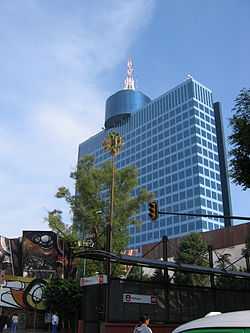World Trade Center Mexico City
| World Trade Center Mexico City | |
|---|---|
 | |
| General information | |
| Status | Complete |
| Type | Office |
| Location | Colonia del Valle, Benito Juárez borough, Mexico City |
| Coordinates | 19°23′40″N 99°10′28″W / 19.3945°N 99.1744°WCoordinates: 19°23′40″N 99°10′28″W / 19.3945°N 99.1744°W |
| Construction started | 1966 |
| Estimated completion | 1972 |
| Opening | 1972 (as Hotel de México) |
| Renovated | 1992–1995 |
| Height | |
| Antenna spire | 207 m (679 ft) |
| Roof | 191 m (627 ft) |
| Top floor | 172 m (564 ft) |
| Technical details | |
| Floor count | 50 |
| Floor area | 239.000 m² |
| Lifts/elevators | 35 |
| Design and construction | |
| Architect | Guillermo Rossell de la Lama y Ramon Miquelajauregui |
| Developer | EUREKA, ESCALA INTERNACIONAL, GUTSA |
The World Trade Center Mexico City, also still commonly called by its former name, Hotel de México, is a building complex located in south-central Mexico City, Mexico. Its most famous and recognizable feature is the 52-story, 207 m (670 ft) high Torre WTC, the third tallest building in Mexico City (including antenna), or fourth when measured by its 191 m (587 ft) roof height. When talking about the World Trade Center México, one usually is referring to the uniquely shaped tower. The complex also includes a convention center, cultural center, parking facilities, a multi-screen cinema, a revolving 45th-floor luxury restaurant, and shopping center with Sears as an anchor tenant. It will also include a 22-floor hotel, which is currently under construction. Located on Avenida de los Insurgentes, the complex is served by the Polyforum station of the Metrobús Bus rapid transit system, located a few meters away. The station is named after the Polyforum Cultural Siqueiros, a part of the WTC complex.
History
The WTC México began its existence as the Hotel de México, a building and complex that never really performed their intended functions.[1]
Construction of the Hotel de México took place in a lot called Parque de La Lama located in Mexico City Napoles neighborhood (Spanish: Colonia Nápoles).[2] The lot was set aside by real estate businessperson José Jerónimo de La Lama in 1947. However, by 1966, when the project was started, the owner and financial sponsor was Manuel Suarez y Suarez.
The Hotel de México project included, a hotel building as well as a cultural center housing the Polyforum Cultural Siqueiros and several other facilities aimed at making the complex a hub for business, culture, tourism, and architecture. Plans for the complex were presented at the 13th international architecture contest in Munich.
Slated to be ready for the 1968 Olympics, the project ran over schedule and over budget and although the main tower was completed in 1972, it never really functioned as a hotel, and, due to political and economical reasons, the tower as well as the rest of the complex were left in an unfinished state, save for the Polyforum.
In the mid 1980s, a project was started to turn the Hotel de México complex into an international business center. Mr. Suárez backed the idea and, although he died in 1988, the remodeling began with partial public funding in 1992. In 1995, the complex, now known as World Trade Center México, opened its doors with the tower now remodeled as an office building, as well as a convention center.
Floors 40 and 41 housed TV studios for Corporación de Noticias e Información (News and Information Corporation). On May 19, 2005, these floors were evacuated after the beginning of a strike at the company occupying these floors, which was responsible for the Canal 40 television network. Currently, floors 40 and 41, home of the late CNI Channel 40, are still closed and in a state of strike.
Most recently, the World Trade Center added a second theater, the 3,000-seat Pepsi Center, which was completed in 2012. It is used primarily for concerts and stage shows.
Intelligent Building
WTC Tower elevators have a seismic detector that detects any movement of earth and therefore automatically stops the elevator at the nearest stop to allow passengers to get off. It is considered an intelligent building, because the light system is controlled by a system called B three, like that of Torre Mayor, Reforma 222 Financial Center, Avantel Reform Building, Residential Forest 1, Forest 2 Residential, Tower the Pony, HSBC Tower, Panorama Santa Fe, Santa Fe City Tower Amsterdam, Santa Fe Pads, St. Regis Hotel & Residences, Tower Hills . WTC Tower is managed by an intelligent system that controls all the facilities and equipment harmoniously and efficiently to protect human life of the tenants. In this system are integrated systems: electrical, hydro-sanitary, elevator and fire protection and has the ability to control the lighting of the building. It also has automatic elevators, it means they are smart and are always on the floors of more influx. The building has an automatic air handler to supply at each level. The building has the following systems:
- System Generation and distribution of chilled water energy saver.
- System Variable Air Volume (Units air handling products and preparations of high-speed at every level of office).
- Extraction System General Sanitary office at every level.
- Mechanical ventilation system, air-in parking,
- Extraction System Mechanics junk room.
References
- ↑ DePalma, Anthony (November 24, 1994). "Mexico City Journal; Don Manuel's Dream Tower: A 50-Story Folly?". New York Times. Retrieved 16 January 2014.
- ↑ "EXPOSWTC". Centro Internacional de Exposiciones y Convenciones World Trade Center. Retrieved August 5, 2011.